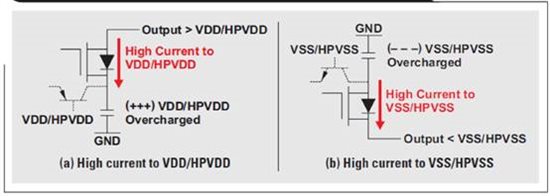In the design, we may connect multiple audio power amplifiers to a single output circuit to reuse different sources, or connect an external amplifier to extend battery life. In addition, we may inadvertently connect one amplifier output to another amplifier output or power supply. All these connections can force the APA output voltage to be abnormal, which can damage the APA. There are some limitations that must be noted to avoid such damage, and the reasons for these limitations are explained in this article.
This damage occurs regardless of whether APA is open or closed. When the APA is turned on, most APA outputs are protected by short circuit protection (SCP) or overcurrent protection (OCP) circuits, but the range of voltages that the APA can withstand remains the same. In general, the voltage forced into the APA output must be set as a lower limit to avoid APA damage: APA output should not be forced to exceed 0.3V above APA's positive supply voltage (VDD or VCC) or below its negative supply voltage (reference voltage or VSS) -0.3V. The APA output shall not be forced to exceed the absolute maximum rated value of the rated supply voltage in the APA product specification. How an APA responds to a voltage forced into its output when turned off, an APA has different resistances in its output, ranging from a few ohms to thousands of ohms at high impedance. If an external audio source connected to the APA output can drive this resistor, it will push the voltage of the APA output. When on, most Class AB devices have SCP persistent current limits. APA keeps its output at the planned output voltage level until it is forced into SCP or OCP by another source. After that, it continues to draw its current limit, but its output voltage is controlled by another source. If the APA continues to draw on its current limits, it may overheat and turn into a thermal shutdown. Its output voltage is completely controlled by another source. When the APA is sufficiently cooled, it will reopen, and the cycle will not stop as long as the external source connection is kept open. A typical Class D APA keeps its output at its planned output voltage level until it is forced into SCP or OCP. Then, as long as there is a certain voltage limit, it is closed, and its output voltage is controlled by another source, and no large current is absorbed. A Class D APA with period-to-period OCP will generally behave like a continuous current limiter until it is turned off. The way the damage occurred
If another source is connected to an APA output while off, it forces the APA output to follow its voltage. If the APA is on and another source can provide enough current to force the APA into SCP or OCP, the other source forces the APA output to follow its voltage. It can be damaged in several different ways. Forward bias main diode
A single-supply APA operates between a positive supply (commonly called VDD or VCC) and a reference voltage. The output devices are some FETs with main diodes, which are reverse-biased in normal operation. If one of these diodes becomes forward-biased and carries too much current, the body diode (see Figure 1), which is reverse-biased in normal operation, can be damaged. This occurs when the single-supply APA is forced to exceed the VDD (or VCC) by 0.3V or below the reference voltage of -0.3V. Figure 1 Current conduction of the forward-biased main diode

FIG. 2 Pushing APA supply voltage beyond its limit

TI DirectPath™ operates between a positive power supply (commonly referred to as VDD) and a negative rail (commonly referred to as VSS, usually produced from a self-on-off circuit VDD), and the VSS level is generally lower than the VDD level. Some DirectPath APAs adjust the main VDD to a lower power level so that it emits an HPVDD and generates a negative track HPVSS from the HPVDD to control the maximum output power. If the output of the DirectPath APA is forced to exceed 0.3V above VDD/HPVDD or -0.3V below VSS/HPVSS, one of the main diodes may become forward biased and carry too much current, damaging the diode. Power supply overvoltage Even if the external power supply current does not damage the main diode, it may flow to VDD/HPVDD or VSS/HPVSS (see Figure 2). VDD/HPVDD and VSS/HPVSS generally only capture current, so the diode current may cause the supply voltage to exceed its absolute maximum rating, and as a result may damage the APA and/or power supply components. Table 1 May be helpful in understanding the different power supplies for various DirectPath APAs. By comparing the product specification data with the table, we can determine that the power supply of the device is not involved here. The power identifiers may differ from those shown in the table.
免责声明: 本文章转自其它平台,并不代表本站观点及立场。若有侵权或异议,请联系我们删除。谢谢! Disclaimer: This article is reproduced from other platforms and does not represent the views or positions of this website. If there is any infringement or objection, please contact us to delete it. thank you! |


